There was something incredibly juxtaposing from RB Leipzig’s 1-1 draw with Atalanta on Thursday evening.
A side doused in a rich tapestry of history travelling to the ribcage of Germany to take on a newfound beast, backed by copious amounts of cash, allowing them to barrage their way to the pinnacles of Europe.
RB Leipzig facing Atalanta in the UEFA Europa League was European football’s fortuitous depiction of Jay Gatsby’s ‘new money’ locking horns with Tom Buchanan’s ‘old money’ from F. Scott Fitzgerald’s esteemed novel. Funnily, just like in ‘The Great Gatsby’, nobody won, although the ending was much less tragic.
The game was certainly thrilling though as both teams shared 31 shots on goal across the ninety minutes plus added time.
Gian Piero Gasperini’s side took the lead early in the first half through Luis Muriel. The sumptuous strike from the Colombian was cancelled out in the second half when Davide Zappacosta converted into his own net to cost his side the lead in Leipzig.
Not only was the game incredibly interesting from a neutral perspective given the contrasting styles of football being put on display, but it was also tactically engrossing.
This article will be a tactical analysis of Thursday’s early quarter-final clash in the Europa League. The analysis will focus on the tactics used by both sides, paying particular emphasis on Atalanta’s newfound structure.
Lineups and formations
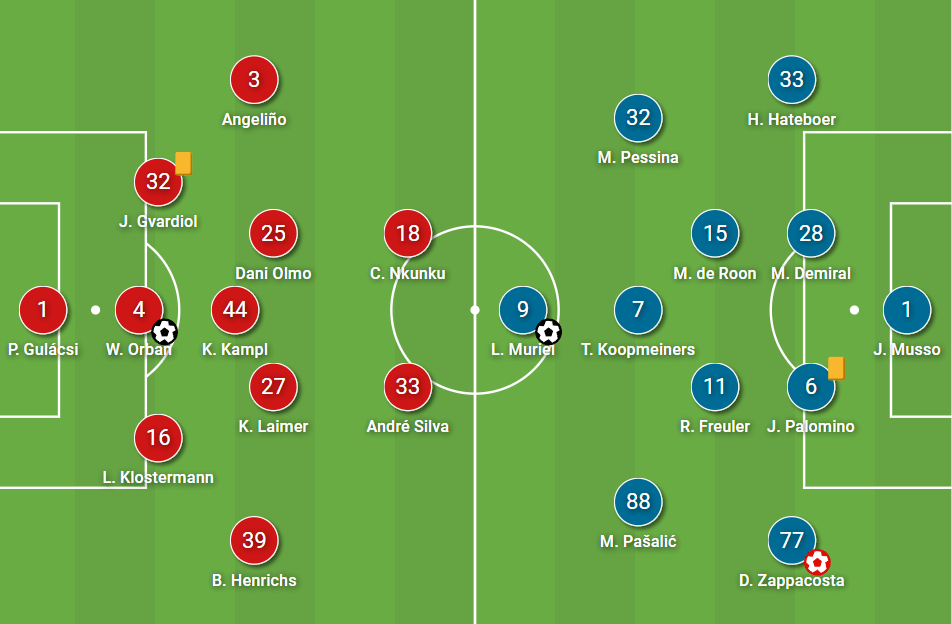
The German arrivistes had come into this crucial clash off the back of 4-1 thrashing of Borussia Dortmund on Saturday in the Bundesliga. Given their dominance against the second-best side in the country, head coach Dominico Tedesco felt there wasn’t much need to change for the midweek bout.
Apart from Benjamin Henrichs replacing Nordi Mukiele at right wingback in Leipzig’s 3-5-2 and Mohamed Simakan coming in for Lukas Klostermann at right centre-back, the side was unchanged.
Unlike his competitor, Gasperini changed Atalanta’s starting lineup quite significantly. However, there was no decision more surprising than the unconventional Italian opting to switch to a conventional back four, something that has become rather unusual with La Dea during his reign.
Atalanta deployed a 4-2-3-1 in this game, as opposed to their usual 3-4-1-2. There was a reason for this though, which will be analysed in further detail later.
Regarding the starting lineup, young defender Giorgio Scalvini missed out, dropping to the bench along with the experienced Berat Djimsiti. Merih Demiral started alongside José Palomino in a two-man partnership at the back.
Marten de Roon, Remo Freuler and Teun Koopmeiners all kept their place in the midfield, but the third was pushed further forward in a number ‘10’ role.
Ruslan Malinovskyi lost out too as the Ukrainian star was placed on the bench with Mario Pašalić and Matteo Pessina completing the midfield, supporting Muriel up top as the lone striker.
Atalanta’s formation change
Gasperini’s decision to switch to a back four seems extremely uncharacteristic. In true Italian fashion, the Atalanta manager is unquestionably dogmatic in his approach and the tactical structure to execute his philosophy.
However, the Bergamo-based club have really struggled for form this season and are holding onto a UEFA Europa Conference League spot for dear life despite finishing third last season.
In a recent outing where Atalanta disposed of Sampdoria 4-0, Gasperini deployed the 4-2-3-1 and then once more in the following game against Jose Mourinho’s AS Roma. Nevertheless, after a 1-0 defeat to the Giallorossi, he scarpered from this shape and reverted to his more nuanced 3-4-1-2.
Nevertheless, the 64-year-old opted to return to the 4-2-3-1, which seems peculiar but there were strategic reasons for it.
One of Atalanta’s core tactical principles in possession is to create wide overloads. Irrespective of the shape they set up in, Gasperini’s side certainly didn’t shy away from this against Leipzig. Typically though, in their 3-4-1-2 formation, one of the wide centre-backs push up higher to join the overload on his flank.

Since the 3-4-1-2 allows for just three centre-backs, it means that once the wide central defender steps up to join the overload, there are just two left in the backline, which is numerically problematic, of course.
Howsoever, Gasperini’s system is, and always will be one of high-risk and high reward. The ex-Internazionale boss knows the weaknesses his style creates but takes a more positive outlook on things because of the consequential damage it can cause too.
If Atalanta lose the ball using these overloads out wide, they counterpress quickly and aggressively to win it back. However, Gasperini knew the dangers of Leipzig in transition and so adding the extra defender at the back allowed them to be that little bit more secure.
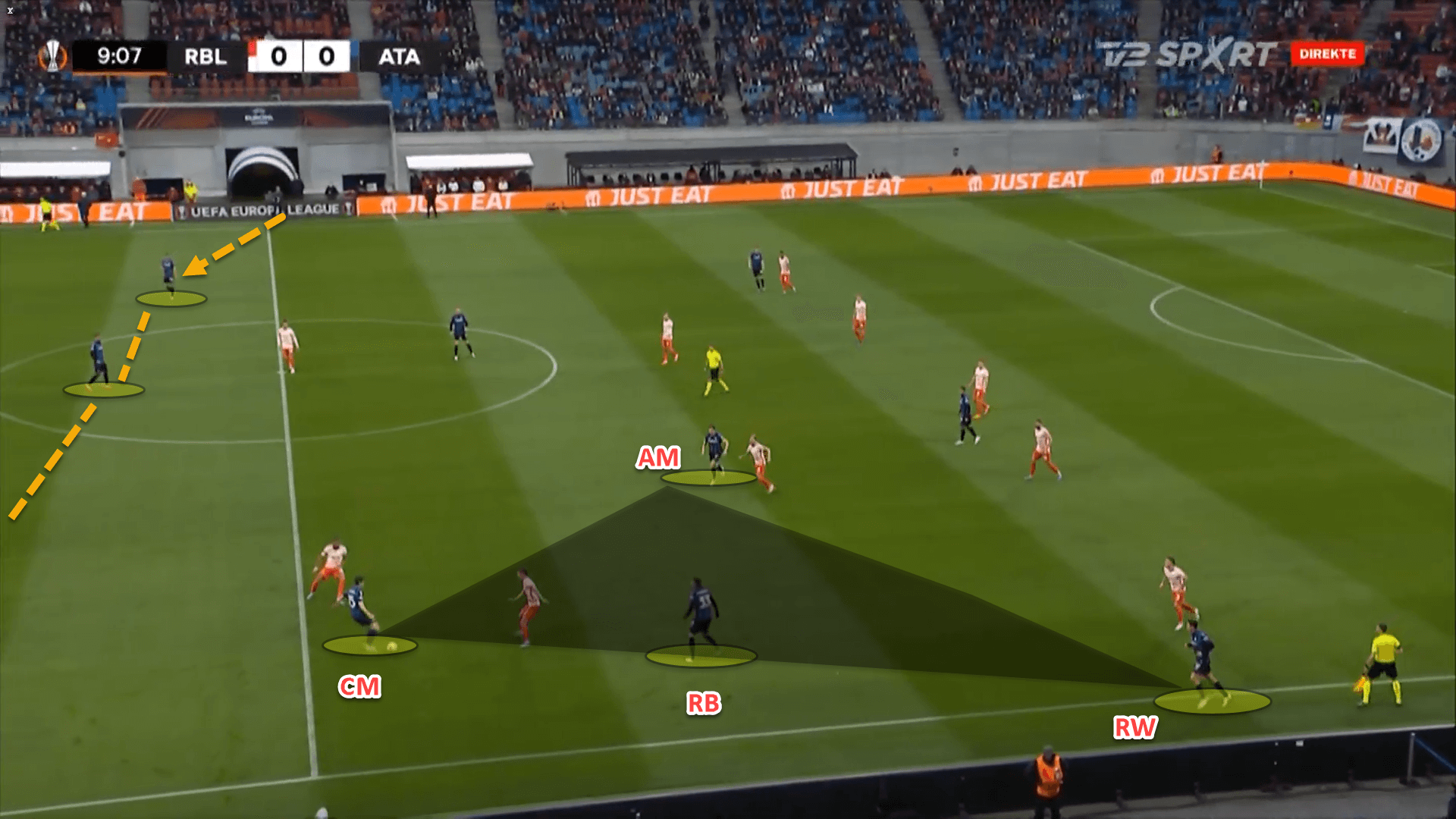
Atalanta pushed the fullbacks higher and dropped the nearest pivot player across for the overloads. In doing so, the opposite fullback tucked inside and created a temporary back three alongside the two centre-backs.
Having the pivot player in these wide positions added even more security in case of a turnover in possession. Leipzig are one of the best sides in Europe in transition and have been for many years, stemming all the way back to Ralf Rangnick’s double-stint in the dugout.
Atalanta’s approach worked as well. La Dea were able to successfully negate Die Roten Bullen’s counterattacks and looked far more sealed off at the back than in recent games.
De Roon constantly pulled out to the space voided by Hans Hateboer pushing further forward on the right which can be seen in Atalanta’s pass map during the game.
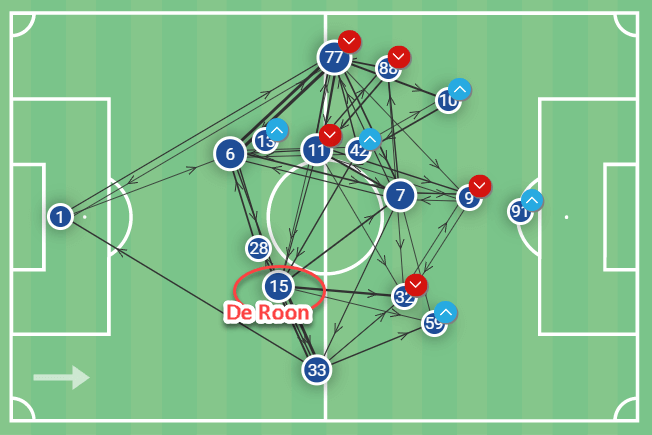
Solid mid-block?
Despite the formation change and the players having to make tiny tweaks during the game, Atalanta were still able to constantly crack open Leipzig’s defensive block on several occasions to create quality goalscoring opportunities.
Tedesco set his team up in a 3-5-2 which dropped into a 5-3-2 out of possession. Leipzig were mainly looking to defend in a medium-level block in the middle of the pitch. They compacted the centre of the park and the halfspaces, allowing the visitors to create their wide overloads where they would try and aggressively regain possession.
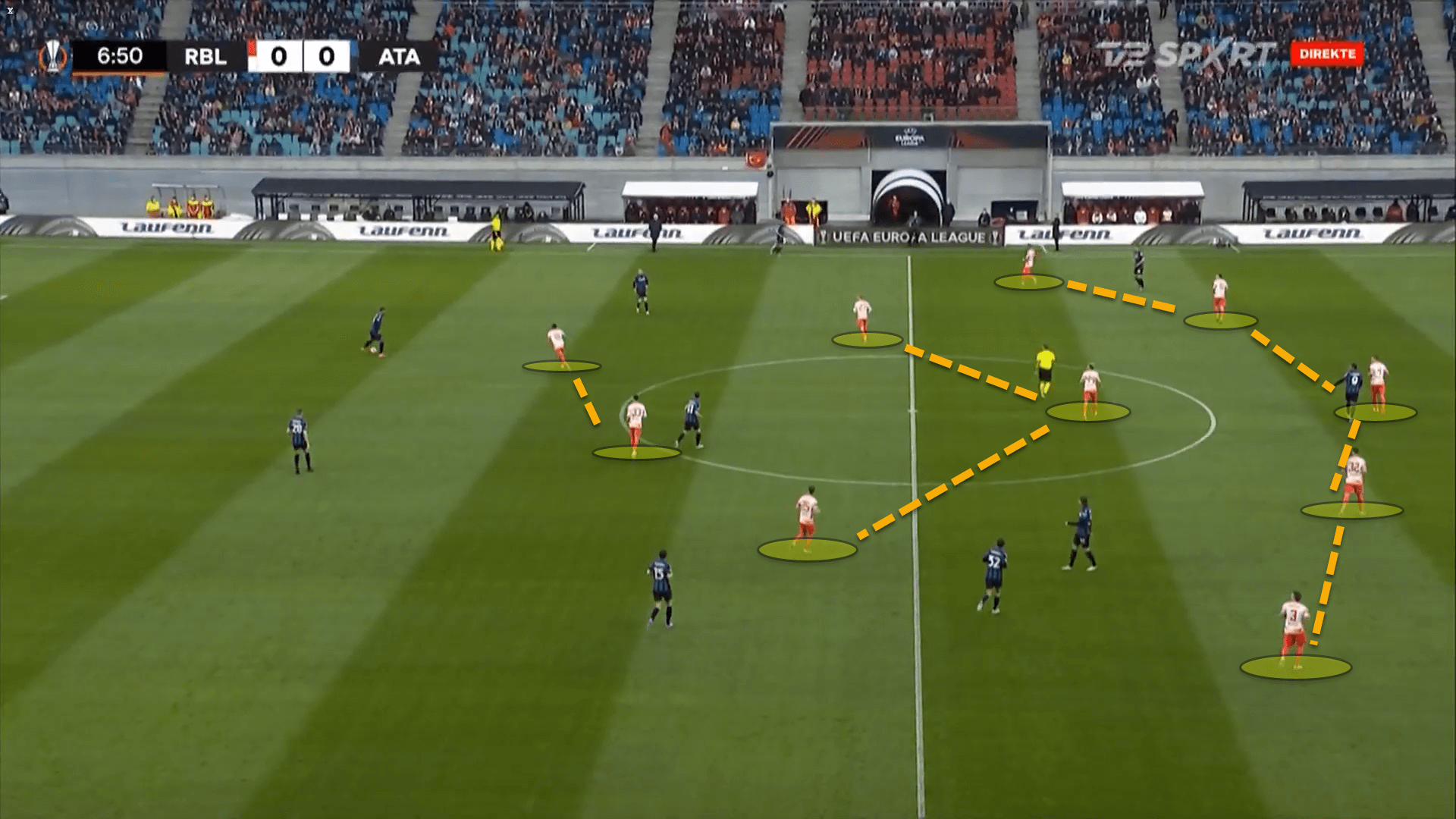
In principle, this sounds absolutely wonderful, setting wide pressing traps to regain possession against one of the best teams in the world at creating chances from the flanks. What could possibly go wrong?
It probably won’t come as a shock to anyone that it, in fact, did go wrong. Atalanta had 44 positional attacks on Thursday evening, 28 of which were down the flanks. Their success down the sides is very noticeable when observing Leipzig’s defensive duels from the game.
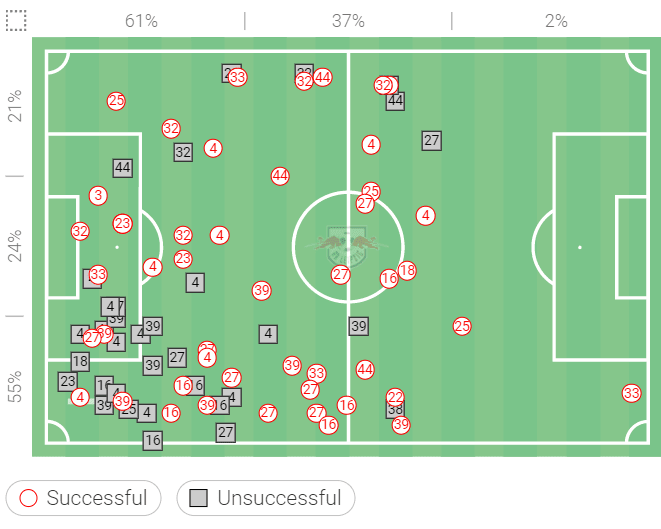
Gasperini’s men leaned more heavily on creating overloads down the left and saw great success from this too. Leipzig attempted 89 defensive duels against Atalanta. 55 percent of these were down their right side which they lost roughly half of.
Atalanta created numerous excellent chances from the wide areas and even punished their opponents on one occasion for the opening goal of the match.
The Italian minnows-cum-heavyweights enacted all of their tactical principles into one for the goal, winning the ball with ease in the final third from Leipzig’s failed counterattack and creating an overload down the left before the ball was beautifully smashed home by Muriel past Péter Gulácsi in the net.
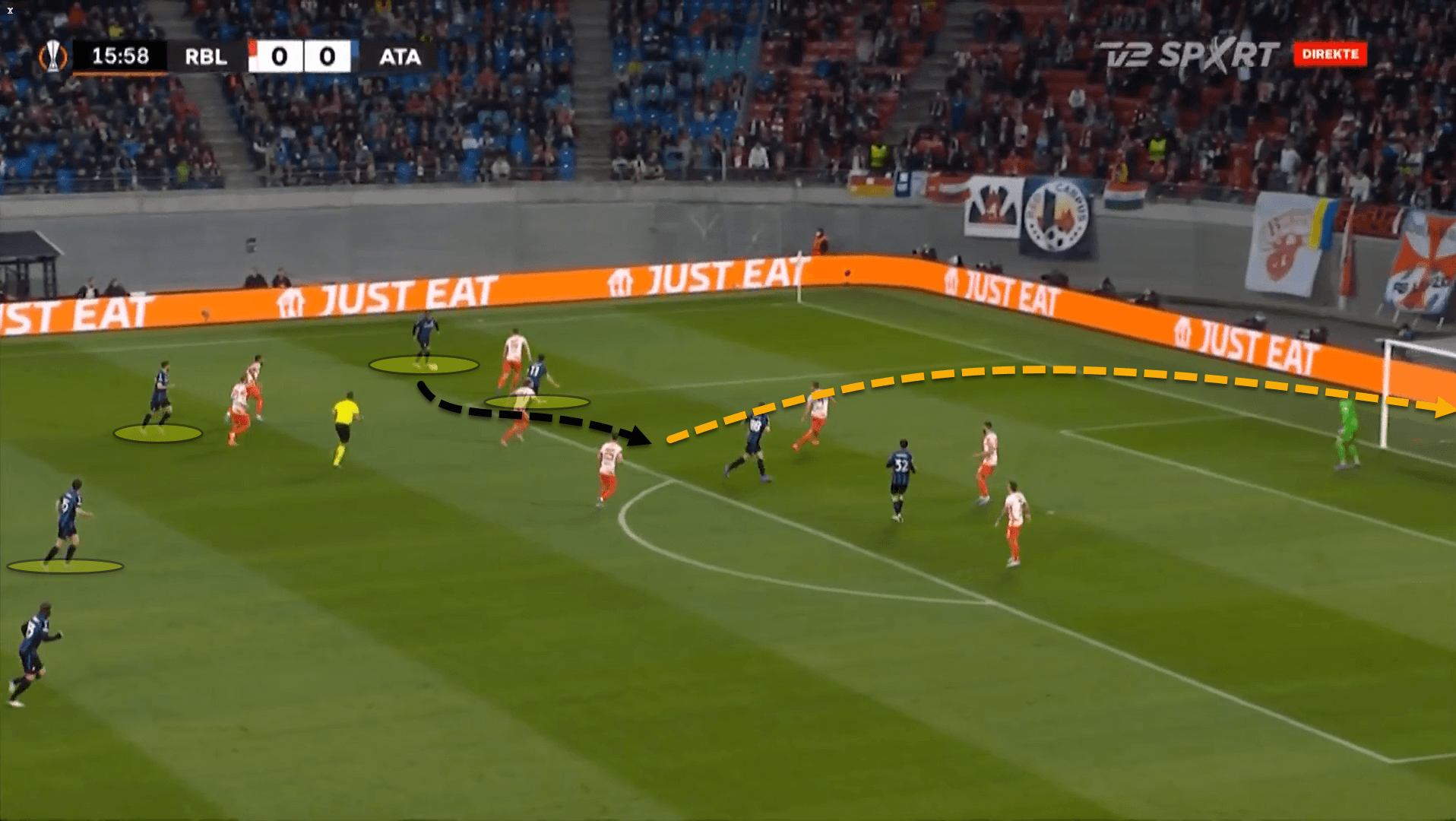
Of course, the game ended as a 1-1 draw, but this certainly flattered to deceive Leipzig by a significant margin. Tedesco’s men conceded an xG of 3.08 throughout the game, none of which was from the penalty spot.
Leipzig’s defensive approach didn’t really work, and they rode their luck for large parts of the game. The Germans did accumulate 1.98 xG of their own but 0.76 of this was from a missed penalty which was expertly saved by Atalanta’s Juan Musso.
There was one downside to Atalanta’s newfound shape in possession with the 4-2-3-1. As Gasperini wanted to be able to control Leipzig’s ability to counterattack, he ensured that one the ball was out on the flanks in the final third, the opposite fullback (the furthest player on the opposite side of the pitch) would tuck inside into the halfspace.
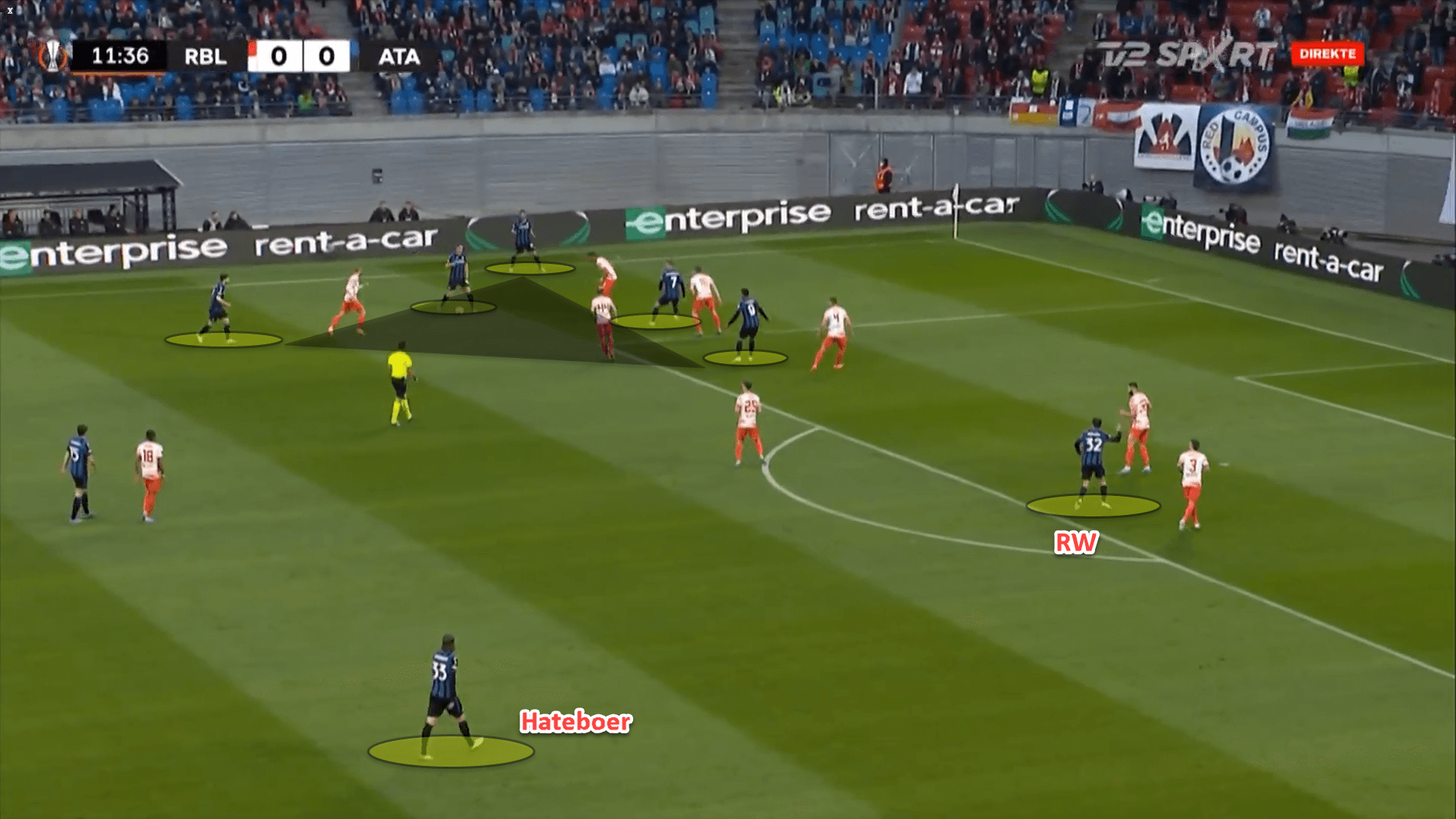
This meant that Atalanta were extremely narrow in possession. Interestingly, their approach resembled that of Leipzig under current Leeds United boss Jesse Marsch from earlier in the season before the American’s dismissal at the helm.
Keeping this narrow of a structure means that there is little to no width but the connections between the players are minimised which allows them to be at a closer proximity to defend transitions as seen in the build-up to Leipzig’s goal.
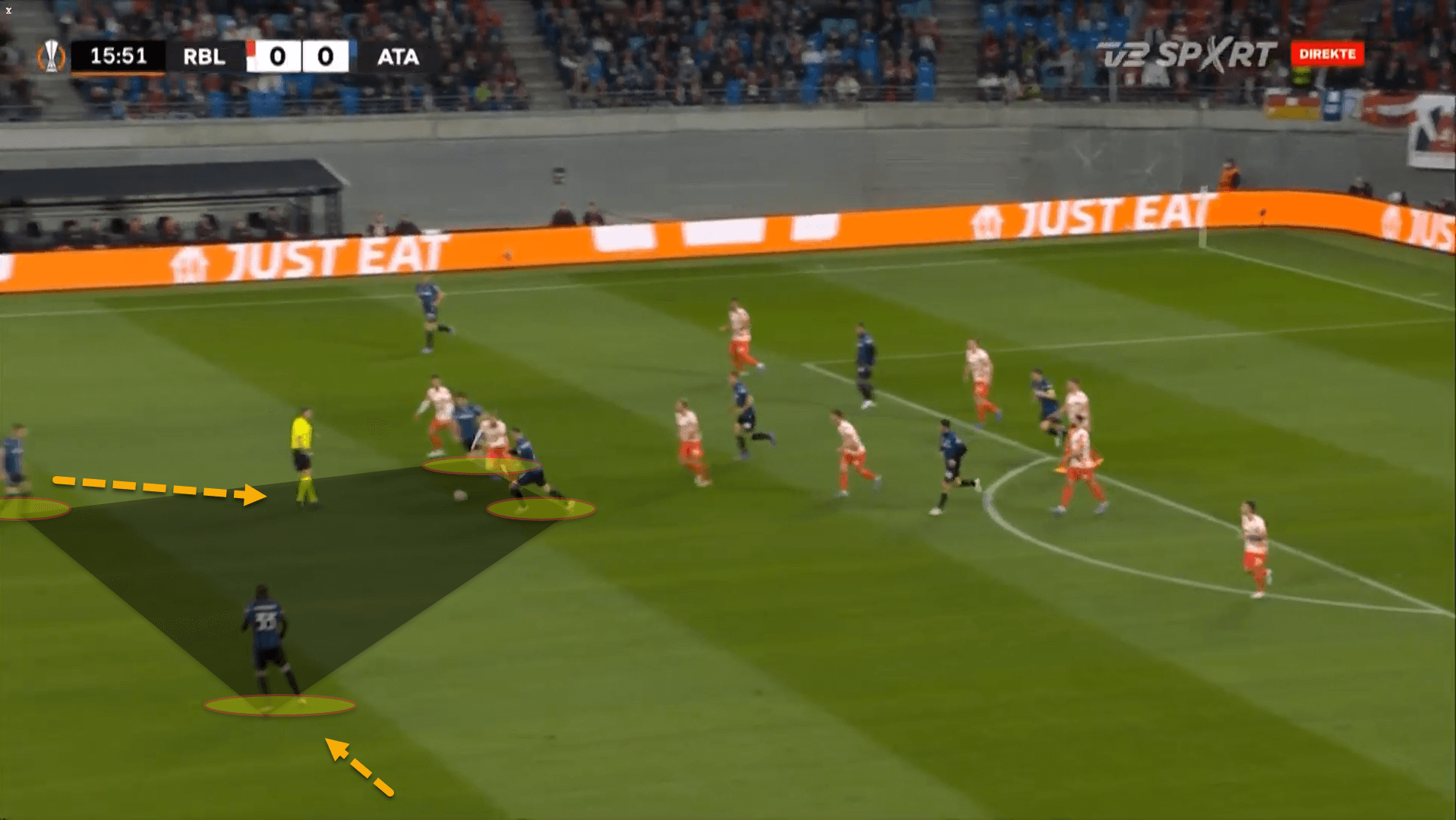
Atalanta’s high press and Leipzig’s direct approach
Leipzig are a side that can cause serious damage in possession. However, against Atalanta, their approach was much more conservative and direct. The Italians held the lion’s share of possession, having 58.3 percent of the ball compared to the hosts’ 41.7 percent.
While the Germans were direct with their transitions, their approach was undeviating during settled attacks as well. What does this mean? Well, essentially, Leipzig would build out from the back, inviting Atalanta to press them in deeper areas before trying to play long to the centre-forwards. They averaged just 3.88 passes per possession on the night.
Firstly though, let’s take a look at La Dea’s pressing scheme. Those who have kept a close eye on Atalanta under Gasperini will know by now that they utilise a man-marking approach out of possession. This is strict and is undeterred by any formation or team they are up against.
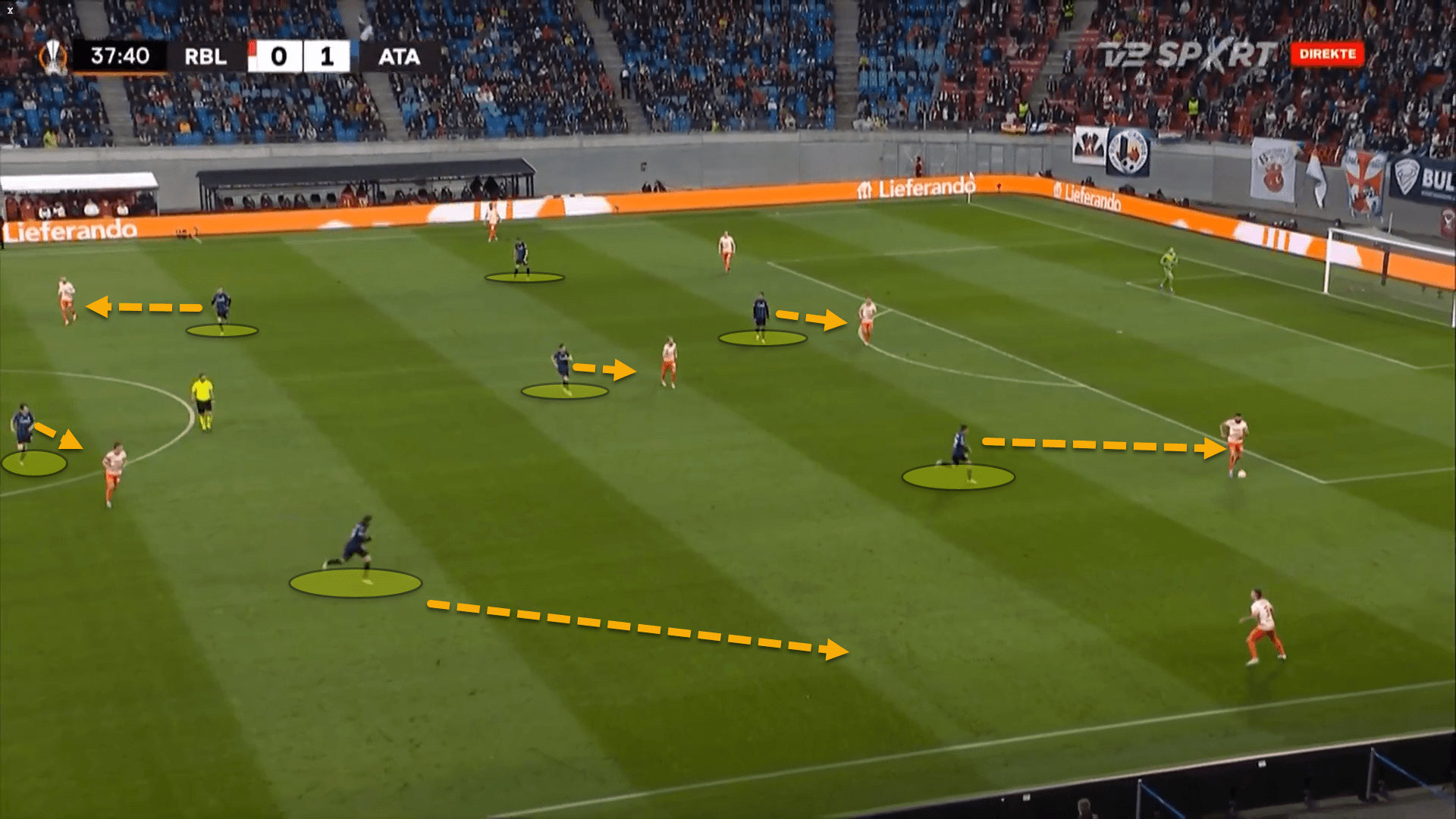
Despite setting up with three centre-backs, Leipzig kept their wingbacks low during the build-up phase, maintaining a back five structure. Having a single pivot and two ‘8’s allowed Atalanta to go man-for-man rather easily in the middle of the park using their 4-2-3-1.
Against the three central defenders, Atalanta used their front three. Again, this matched up well. Nevertheless, the fullbacks were given differing roles. Hateboer would join the high press and applied pressure to Angelino on the right.
Basically, they went 4v5 against Leipzig’s back five. What this meant was that one of Atalanta’s forwards had to mark two players. Pašalić was tasked with performing this role over on the left.
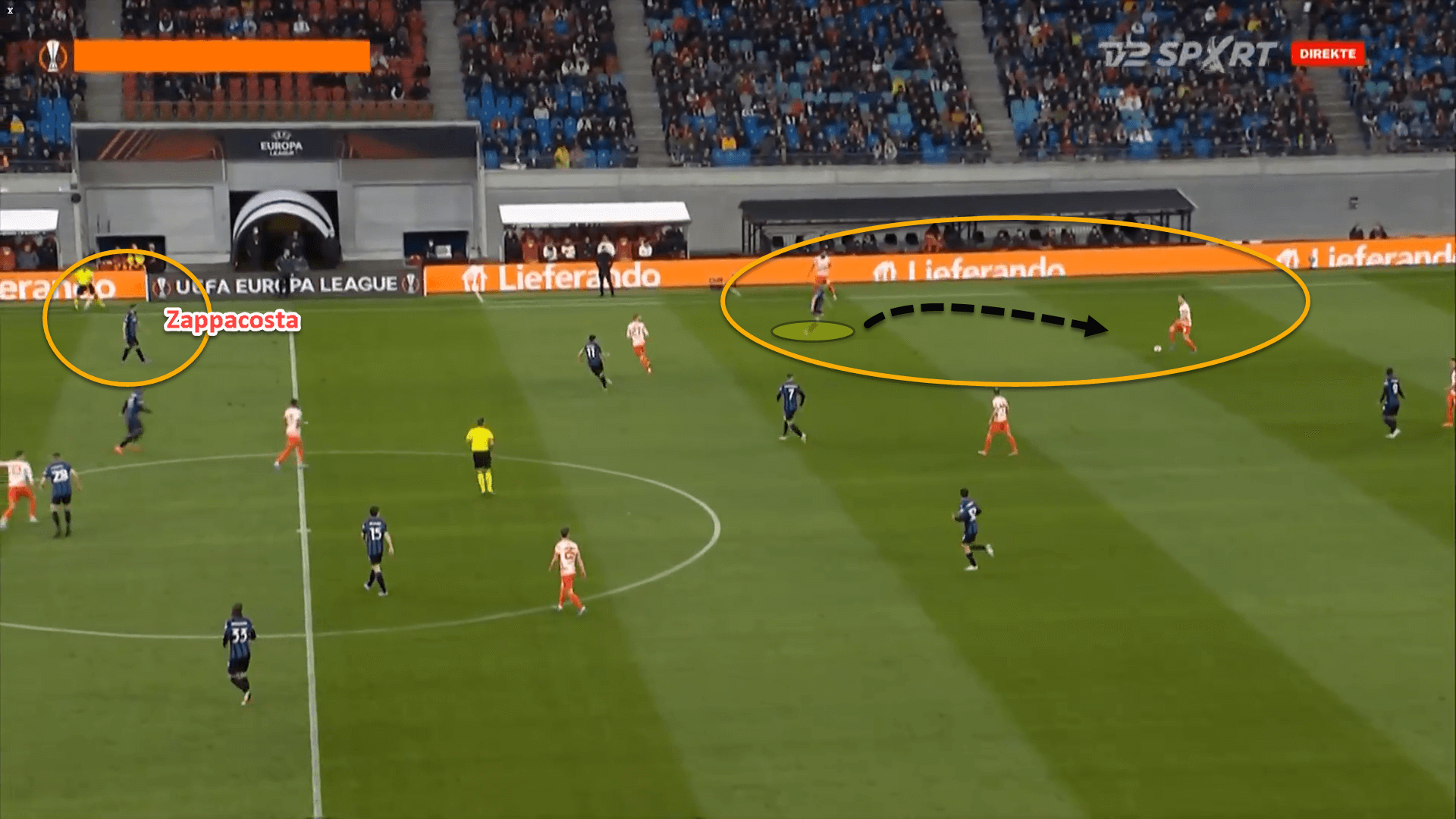
Pašalić would deal with this by inverting his pressure, going from outside to inside, and cutting off the passing lane to Leipzig’s right wingback Henrichs.
By doing so, the Croatian would allow Davide Zappacosta to stay back as a free man out of possession alongside the centre-backs. Once again, this shored up Atalanta’s defence just a bit more than it has been recently.
Leipzig were struggling to play through Atalanta and so began using countermovements to get in behind with their strikers. Countermovements are just basic manoeuvres on the pitch where one player drops and the other runs in behind simultaneously. As Atalanta are man-oriented, this could have worked in their favour.
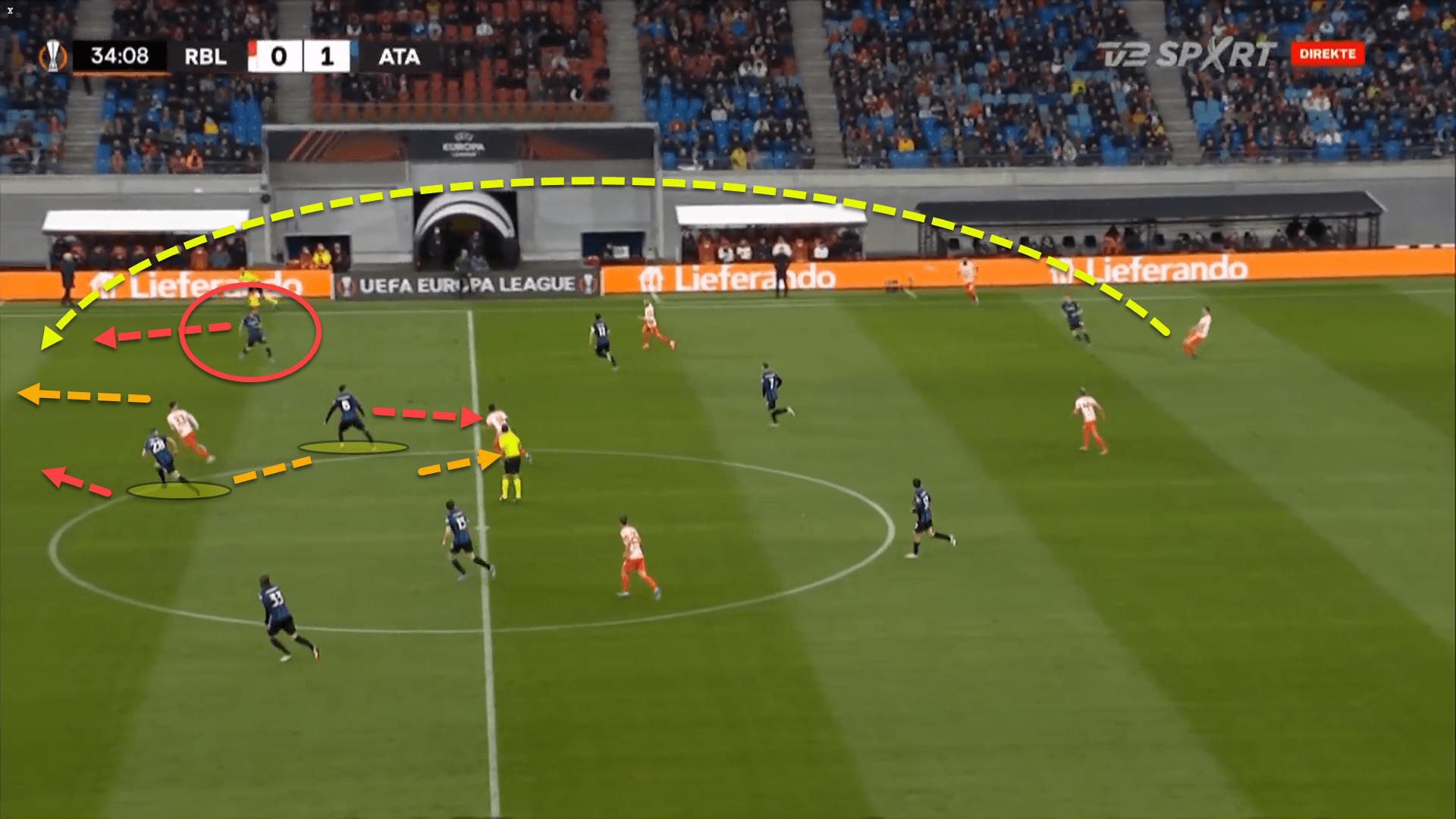
For instance, here, Christopher Nkunku dropped short, dragging out Palomino. Automatically, Andre Silva darted into the vacant space, looking for the long ball from the centre-back.
However, Gasperini was smart. Once more, the switch to the 4-2-3-1 worked wonders tactically for them. When situations like this arose, Atalanta were able to go 2v1 in the channels chasing the balls in behind because Zappacosta was staying back.
This even worked when Konrad Laimer ran the channel too which was a common automatism for the home team. This is noticeable by how high the Austrian international was positioned on Leipzig’s pass map. His positioning was the third-highest for Die Roten Bullen on Thursday.
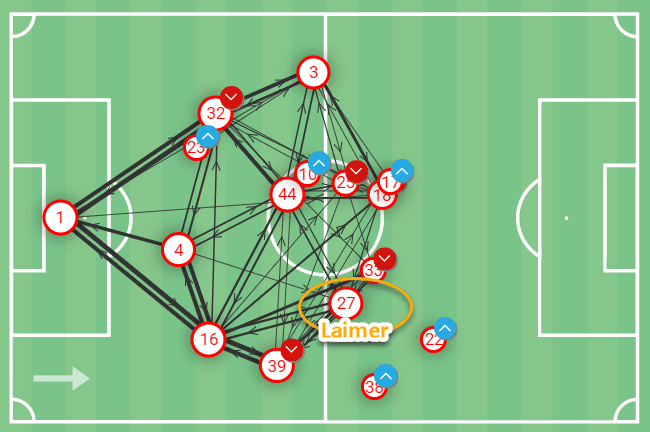
Gasperini is no spring chicken. He may be an attacking dogmatist but he’s still Italian. Catenaccio runs through his Torinese blood. Un lavoro ben fatto, Signore!
Conclusion
The game was truly fascinating for any neutral fan. On an entertainment level, it was certainly captivating but the tactical battle between two minds that are 24 years apart in age also made for a thrilling game.
Atalanta possibly could have and maybe should have taken the victory home with them on their return flight, but Leipzig did also hit the post twice so beggars can’t be choosers.
Nevertheless, the first leg drew an inconclusive ending and so there is everything left to play for when the sides meet next Thursday in Bergamo to round off the Europa League quarter-finals. If the second leg is anywhere near as exhilarating, football fans are in for a treat.






Comments